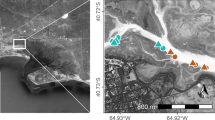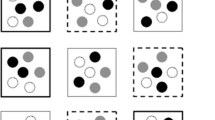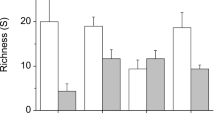Abstract
Changes in macroalgal community structure caused by invasive seaweeds have strong impacts on the associated macrofauna due to the role of macroalgae as autogenic ecosystem engineers. This study investigates the effect of Undaria pinnatifida on the abundance and diversity of benthic macrofauna in Golfo Nuevo, northern Patagonia, using a manipulative experiment involving the systematic removal of Undaria microthalli from strips of hard bottom during its eighth-month growing period. Species richness and diversity were higher in plots covered by Undaria than when Undaria was removed. Also, the abundance of two species of crustaceans, one species of sea urchin, one species of nemertina and several species of polychaetes was higher. We attribute these effects to the provision of new habitat structure by Undaria, a larger and structurally more complex species than the local native seaweeds. These results support the hypothesis that complex habitats enhance abundance and species richness, by offering different shelter and foraging opportunities compared to morphologically simpler habitats. Based on a review of diet studies in the region, we speculate that Undaria could potentially produce a bottom-up effect on local food chains by increasing abundance of prey for a wide variety of predators, from invertebrates to marine mammals. While our study has a narrow temporal and spatial scale, we expect similar effects of Undaria on the macrofauna in other sites of the Argentine coast, especially those dominated by small native macroalgae.



Similar content being viewed by others
References
Akiyama K, Kurogi M (1982) Cultivation of Undaria pinnatifida (Harvey) Suringar, the decrease in crops from natural plants following crop increase from cultivation. Tohoku Reg Fish Res Lab Bull 44:91–100
Bigatti G, Sacristán S, Rodríguez MC, Stortz CA, Penchaszadeh PA (MS-a) Diet, prey narcotization and biochemical composition of salivary glands of the volutid snail Odontocymbiola magellanica
Bigatti G, Sanchez Antelo CJM, Miloslavich P, Penchaszadeh PE (MS-b) Feeding behavior of Adelomelon ancilla: a predatory neogastropod in Patagonian benthic communities
Bolam SG, Fernandes TF (2002) The effects of macroalgal cover on the spatial distribution of macrobenthic invertebrates: the effect of macroalgal morphology. Hydrobiologia 475(476):437–448
Bolam SG, Fernandes TF, Read P, Raffaelli D (2000) Effects of macroalgal mats on intertidal sandflats: an experimental study. J Exp Mar Biol Ecol 249:123–137
Buschbaum C, Chapman AS, Saier B (2006) How an introduced seaweed can affect epibiota diversity in different coastal systems. Mar Biol 148:743–754
Casas GN, Piriz ML, Parodi EL (2008) Population features of the invasive kelp Undaria pinnatifida (Phaeophyceae:Laminariales) in Nuevo Gulf (Patagonia, Argentina). J Mar Biol Assoc UK 88(1):21–28
Chemello R, Milazzo M (2002) Effect of algal architecture on associated fauna: some evidence from phytal molluscs. Mar Biol 140:981–990
Curiel D, Rismondo D, Marzocchi M, Solazzi A (1994) Distribuzione di Undaria pinnatifida (Harvey) Suringar (Laminariales, Phaeophyta) nella laguna di venezia. Soc veneziana Sci Nat 19:121–126
Development Core Team R (2007) R: A language and environment for statistical computing. R Foundation for Statistical Computing, Vienna, Austria
Duarte CM (1995) Submerged aquatic vegetation in relation to different nutrient regimes. Ophelia 41:87–112
Eyras MC, Boraso AL (1994) Aspectos de la estrategia reproductiva de Macrocystis Pyrifera (Phaeophyta, Laminariales) en poblaciones de la costa Argentina. Nat patagónica 2:33–47
Feisinger P (2001) Designing field studies for biodiversity conservation. Island Press. Washington, Covelo, London
Fletcher RL, Manfredi C (1995) The occurrence of Undaria pinnatifida (Phaeficeae, Laminariales) on the South coast of England. Botanica Marina 38:355–358
Forrest BM, Taylor MD (2002) Assessing invasion impact: survey design considerations and implications for management of an invasive marine plant. Biol Invasions 4:375–386
Galván DE (2008) Ensambles de peces en los arrecifes norpatagónicos: diversidad. abundancia y relaciones tróficas y con el hábitat, Doctoral tesis, Universidad Nacional Del Comahue
Galván DE, Botto F, Parma A, Bandieri L, Mohamed N, Iribarne OO (2009) Food partitioning and spatial subsidy in shelter-limited fishes inhabiting patchy reefs of Patagonia. J Fish Biol 75:2585–2605
Gosztonyi AE, Kuba L (1998) Fishes in the diet of the imperial cormorant Phalacrocorax atriceps at Punta Lobería, Chubut, Argentina. Mar Ornithol 26:59–61
Gribben PE, Wright JT (2006) Invasive seaweed enhances recruitment of a native bivalve: roles of refuge from predation and the habitat choice of recruits. Mar Ecol Prog Ser 318:177–185
Gribben PE, Wright JT, O’Connor WA, Doblin MA, Eyre B, Steinberg PD (2009) Reduced performance of native infauna following recruitment to a habitat-forming invasive marine alga. Glob Chang Ecol 158:733–745
Hay HC (1990) The dispersal of sporophytes of Undaria pinnatifida by coastal shipping in New Zealand, and implications for further dispersal of Undaria in France. Br Phycol 25:301–313
Herrera G, Punta G, Yorio P (2005) Diet specialization of Olrog’s Gull Larus atlanticus during the breeding season at Golfo San Jorge, Argentina. Bird Conserv Int 15:89–97
Hidalgo FJ, Silliman BR, Bazterrica MC, Bertness MD (2007) Predation on the Rocky Shores of Patagonia, Argentina. Estuar and Coasts 30:886–894
Johnson CR (2007) Seaweed invasions: conclusions and future directions. Botanica Marina 50:451–457
Johnson CR, Chapman ARO (2007) Seaweed invasions: introduction and scope. Botanica Marina 50:321–325
Kraufvelin P, Salovius S (2004) Animal diversity in Baltic rocky shore macroalgae: can Cladophora glomerata compensate for lost Fucus vesiculosus? Estuarine. Coast Shelf Sci 61:369–378
Krebs CJ (1989) Ecological methodology. Harper Collins Publishers, New York
Lotze HK, Lenihan HS, Bourque BJ, Bradbury RH, Cooke RG, Kay MC, Kidwell SM, Kirby MX, Peterson CH, Jackson GBC (2006) Depletion, degradation, and recovery potential of Estuaries and Coastal Seas. Science 312:1806–1809
Martin JP, Bastida R (2008) El alga invasora Undaria pinnatifida (Harvey) Suringar en la Ría Deseado (Patagonia austral, Argentina): ciclo del esporofito y factores ambientales determinantes de su distribución. Rev Biol Marina Oceanogr 43(2):335–344
Ré ME, Kuba L, Márquez F, Hermosilla C (2006) Dieta del pulpo colorado (Enteroctopus megalocyathus) en la costa patagónica argentina. Argentina, VI Jornadas Nacionales de Ciencias del Mar, Puerto Madryn
Salinas JM, Llera EM, Fuertes C (1996) Nota sobre la prescencia de Undaria pinnatifida (Harvey) Suringar (Laminariales, Paheophyta) en Asturias (mar cantábrico). Inst Esp Oceanogr Bol 12:77–79
Sapoznikow A (2006) Ecología reproductiva y trófica del cormorán cuello negro (Phalacrocorax magellanicus) en relación a las características de su fuente de alimento. Doctoral tesis, Facultad de Ciencias Exactas y Naturales, Universidad de Buenos Aires
Schaffelke B, Hewitt CL (2007) Impacts of introduced seaweeds. Botanica Marina 50:397–417
Schmidt AL, Scheibling RE (2007) Effects of native and invasive macroalgal canopies on composition and abundance of mobile benthic macrofauna and turf-forming algae. J Exp Mar Biol Ecol 341:110–130
Stegenga H (1999) Undaria pinnatifida in Nederland gearriveerd. Het Zeepaard 59:71–73
Stuart MD (2004) Review of research on Undaria pinnatifida in New Zealand and its potential impacts on the eastern coast of the South Island. Department of Conservation, Wellington, New Zealand
Teso SV, Bigatti G, Casas GN, Piriz ML, Penchaszadeh PE (2009) Do native grazers from Patagonia, Argentina consume the invasive kelp Undaria pinnatifida? Rev Mus Argent de Cienc Nat 11(1):7–14
Wotton DM, O`Brien C, Fergus JD, Stuart MD (2004) Eradication success down under: heat treatment of a sunken trawler to kill the invasive seaweed Undaria pinnatifida. Mar Pollut Bull 49:844–849
Yorio P, Bertellotti NM (2002) Espectro trófico de la gaviota cocinera (Larus dominicanus) en tres áreas protegidas de chubut, Argentina. Hornero 17(2):91–95
Acknowledgments
We thank Mariano Cuestas, Martin de Francesco, Andrea Marino, Pedro Fiorda and Fabian Quiroga for their disinterested support in the field and Emilia Diez for the identification of polychaetes. We are particularly grateful to Enrique Amoroso and the interdisciplinary group “We review your paper for a large meal” for their comments. Field work was financed by PADI Foundation. AJI was supported by the ‘Consejo Nacional de Investigaciones Científicas y Técnicas (CONICET)’ of Argentina.
Author information
Authors and Affiliations
Corresponding author
Rights and permissions
About this article
Cite this article
Irigoyen, A.J., Trobbiani, G., Sgarlatta, M.P. et al. Effects of the alien algae Undaria pinnatifida (Phaeophyceae, Laminariales) on the diversity and abundance of benthic macrofauna in Golfo Nuevo (Patagonia, Argentina): potential implications for local food webs. Biol Invasions 13, 1521–1532 (2011). https://doi.org/10.1007/s10530-010-9910-9
Received:
Accepted:
Published:
Issue Date:
DOI: https://doi.org/10.1007/s10530-010-9910-9




